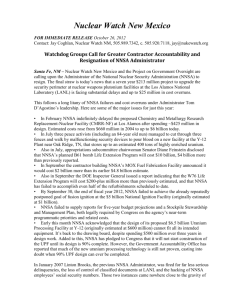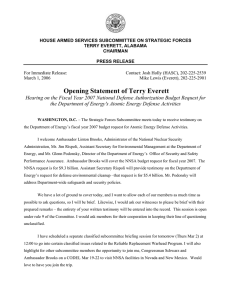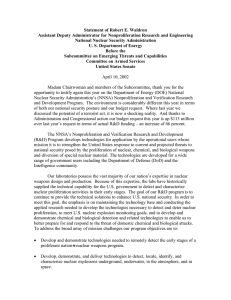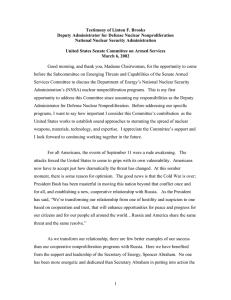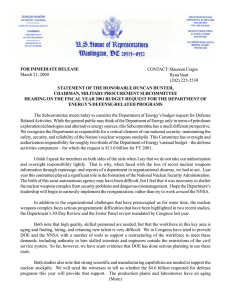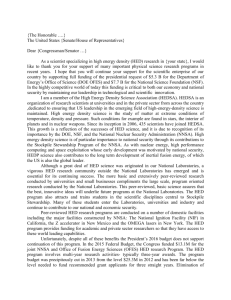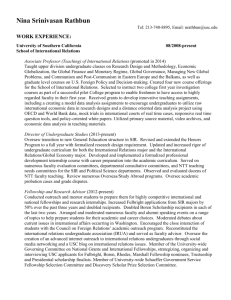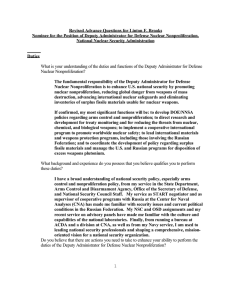GAO
advertisement
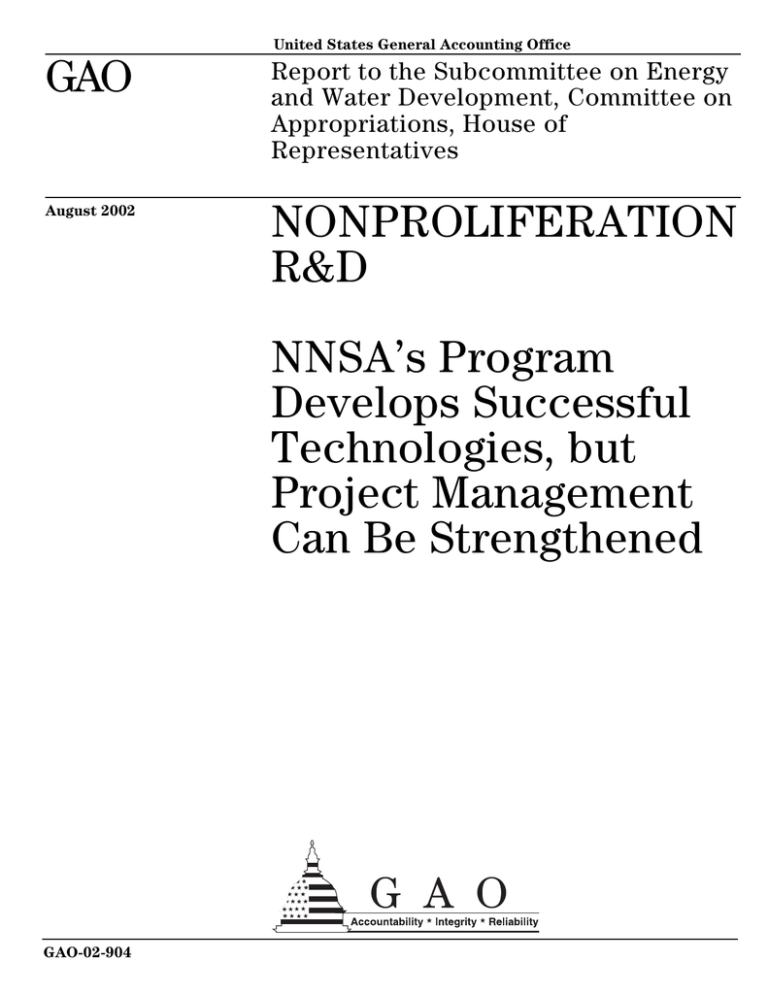
United States General Accounting Office GAO Report to the Subcommittee on Energy and Water Development, Committee on Appropriations, House of Representatives August 2002 NONPROLIFERATION R&D NNSA’s Program Develops Successful Technologies, but Project Management Can Be Strengthened GAO-02-904 Contents Letter 1 Results in Brief Background Of the $1.2 Billion That the Nonproliferation and Verification R&D Program Received over 5 Years, Nearly 75 Percent Went to the 3 NNSA National Laboratories Two of Three Research Areas in NNSA’s R&D Program Have No Process to Identify Users’ Needs and Lack a Transparent System to Monitor Project Progress Users Generally Satisfied with Technologies Developed by NNSA, but Some Feel Their Most Immediate Needs May Be Going Unaddressed Conclusions Recommendations for Executive Action Agency Comments 3 6 16 20 20 21 Appendix I Objectives, Scope, and Methodology 23 Appendix II Comments from the National Nuclear Security Administration 26 7 11 Table Table 1: Distribution of Nonproliferation and Verification R&D Program Funding to DOE National Laboratories and Facilities, Fiscal Years 1998-2002 9 Figures Figure 1: Appropriations to NNSA’s Nonproliferation and Verification R&D Program, Fiscal Years 1998-2002 Figure 2: Distribution of Funding to Nonproliferation and Verification R&D Program’s Research Areas, Fiscal Year 2002 Page i 8 10 GAO-02-904 Nonproliferation R&D Abbreviations DOE NISC NNSA R&D Page ii Department of Energy Nonproliferation and International Security Center National Nuclear Security Administration Research and development GAO-02-904 Nonproliferation R&D United States General Accounting Office Washington, DC 20548 August 23, 2002 The Honorable Sonny Callahan Chairman The Honorable Peter J. Visclosky Ranking Minority Member Subcommittee on Energy and Water Development Committee on Appropriations House of Representatives The mission of the National Nuclear Security Administration’s (NNSA)1 Nonproliferation and Verification Research and Development (R&D) Program is to conduct needs-driven research, development, testing, and evaluation of new technologies that are intended to strengthen the United States’ ability to prevent and respond to nuclear, chemical, and biological attacks. The Department of Energy’s (DOE) national laboratories carry out most of the program’s research, while officials at NNSA’s headquarters and operations offices provide general oversight and contracting support and serve as liaisons to users of the technology developed.2 NNSA’s program makes these technologies available to a number of users from federal agencies—such as the Departments of Defense, Energy, and State; the Customs Service (in the Department of the Treasury); and intelligence agencies—and to state and local law enforcement agencies.3 1 NNSA was created in March 2000 as a separately organized agency within the Department of Energy. It is responsible for enhancing the safety, reliability, and performance of the nation’s nuclear weapons; maintaining the nation’s ability to design, produce, and test nuclear weapons; preventing the proliferation of weapons of mass destruction; and designing, building, and maintaining naval nuclear propulsion systems. 2 DOE manages the largest laboratory system of its kind in the world. The mission of its 23 national laboratories has evolved. Originally created to design and build atomic bombs, these laboratories have since expanded to conduct basic and applied research in many disciplines—from high-energy physics to advanced computing. 3 Other federal agencies—such as the Department of Defense, National Institutes of Health, Centers for Disease Control and Prevention, and intelligence agencies—share responsibility with NNSA for counterterrorism R&D efforts and develop complementary technologies designed to detect and respond to the use of weapons of mass destruction. For example, the Department of Defense is developing technology to protect combatants from chemical and biological agents, and the National Institutes of Health are developing new or improved vaccines, antibiotics, and antivirals in the event of a biological attack. Page 1 GAO-02-904 Nonproliferation R&D Following the September 11th terrorist attacks, the federal government has used technologies developed by NNSA’s program to, among other things, monitor air samples from the World Trade Center site for hazardous chemicals and to assist the cleanup of congressional office buildings contaminated by anthrax. In addition, the Washington Metropolitan Area Transit Authority has received equipment developed by this program to detect chemical agents in the Washington, D.C., subway system (Metro). As of fiscal year 2002, the Nonproliferation and Verification R&D Program had approximately 220 projects under development. Work carried out in these projects covers a wide spectrum of activities, ranging from manufacturing specialized satellite-based sensors that detect nuclear explosions to exploratory research projects to test whether a technical idea with a plausible application to a nuclear, chemical, or biological nonproliferation mission is feasible. The program is currently divided into three specific research areas labeled as follows: • Nuclear Explosion Monitoring. Develops and manufactures groundand satellite-based sensors and computer software for detecting, locating, identifying, and characterizing nuclear explosions when they occur underground, underwater, in the atmosphere, or in space. • Proliferation Detection. Develops, demonstrates, and delivers longand short-range sensor technologies to detect the spread of nuclear, chemical, and biological weapons, materials, and technologies worldwide.4 • Chemical and Biological National Security. Develops, demonstrates, and delivers systems to improve the United States’ capability to prepare for and respond to chemical and biological attacks. This report examines the (1) funding the program received over the past 5 years and the program’s distribution of this funding to the national laboratories and, for fiscal year 2002, throughout its three research areas; 4 Prior to fiscal year 2002, the program had a Deterring Proliferation research area that developed short-range radiation detection technologies, advanced nuclear materials analysis methods, and microtechnologies for detection and analysis of proliferation activities. In October 2001, the efforts of this research area were consolidated into the Proliferation Detection research area. Page 2 GAO-02-904 Nonproliferation R&D (2) extent to which the program identifies users’ needs and monitors project progress; and (3) views of federal, state, and local agencies of the usefulness of program-developed technology, particularly in light of heightened homeland security concerns following September 11, 2001. Results in Brief From fiscal year 1998 through fiscal year 2002, the Nonproliferation and Verification R&D Program received an average of about $218 million per year, for a total of about $1.2 billion. Nearly 75 percent of the $1.2 billion was distributed for R&D at three NNSA national laboratories, Los Alamos and Sandia National Laboratories in New Mexico and Lawrence Livermore National Laboratory in California. About 14 percent was distributed to 10 other national laboratories and DOE facilities. The remaining funding was used for the construction of a Nonproliferation and International Security Center at the Los Alamos National Laboratory, grants to universities and small businesses, and cooperative support for other federal agencies’ counterterrorism R&D activities—such as R&D for chemical and biological detector technology conducted by the U.S. Army. In fiscal year 2002, the program received a significant funding increase. The program was appropriated a total of about $323 million, which included $78 million from the $40 billion emergency supplemental appropriations act passed in the wake of the September 11, 2001, terrorist attacks. Regarding the amount of funding distributed by research area in fiscal year 2002, 37 percent of the total $323 million (about $119 million) was allocated to the Proliferation Detection research area; 26 percent (about $81 million) to the Chemical and Biological National Security research area; and 23 percent (about $76 million) to the Nuclear Explosion Monitoring research area. Two of the three research areas of the Nonproliferation and Verification R&D Program lack a formal process to identify users’ needs and the tools used to monitor project progress are inadequate. In terms of users, NNSA’s role is to develop technologies for, and transfer them to, users in the federal government, the intelligence community, law enforcement, and others. Because of this, it is important that these users have input to project planning and selection and are kept involved as projects progress. However, we found that the Chemical and Biological National Security research area and the Proliferation Detection research area generally lack a formal process for identifying users’ needs during various stages of project development: from input on which projects to fund, to updates on ongoing research. The research areas lack this process because, according to program managers and national laboratory officials, the research in these two areas is, in many cases, considered to be long-term and the Page 3 GAO-02-904 Nonproliferation R&D feasibility of the resulting technology is usually unknown. Thus, these officials believe that user involvement should not occur until the research is more mature. However, two separate advisory committees to NNSA reported in 2000 and again in 2002 that successfully transferring new technologies to users would be aided by opening communications with potential users as early as possible and continuing these communications through all phases of the R&D project. In terms of project monitoring, the program requires that projects’ lifecycle plans and quarterly reports contain detailed information on project time frames, milestones, users of technologies, and deliverables. However, we found that many of the projects’ life-cycle plans and quarterly reports in the Chemical and Biological National Security research area and much of the Proliferation Detection research area did not contain the required information. In the Chemical and Biological National Security research area, for example, lack of data occurs because this research area allocates funds to all projects in the area in a single allotment to each national laboratory rather than to individual projects (as is done for the other research areas). As a result, projects’ life-cycle plans and quarterly reports for this research area at each laboratory are consolidated into single laboratory-wide reports from which it is difficult to glean specific project data. Officials from this research area were therefore unable to provide us with even a list of their ongoing projects. The program maintains a program management information system to track the distribution of funding from NNSA headquarters to individual projects at the national laboratories. However, the system is not designed to capture—on an individual project, research area, or programwide basis—whether projects are on time or within budget. Instead, program managers obtain project progress and budget information largely through personal interaction with project leaders at the laboratories. This report recommends strengthening project plans, reports, and information systems to better capture individual project milestones and expenditures. Officials from federal, state, and local agencies that use technology developed by NNSA’s R&D program have found the technology useful, but some question whether the program is achieving the right mix of long-term and short-term research, especially after the terrorist attacks of September 11, 2001. According to program officials, long-term technology needs are not always well understood by users, and current technologies will eventually become obsolete and/or understood by adversaries. Therefore, new capabilities through long-term research must be constantly pursued. However, some users said that, faced with the continuing terrorist threat, NNSA’s R&D program needs to concentrate on communicating with and Page 4 GAO-02-904 Nonproliferation R&D addressing the immediate needs of the user and “first responder” communities. For example, according to an official with the Washington Metropolitan Area Transit Authority, while it is satisfied with the technologies already provided by NNSA, no federal agency is currently offering the Transit Authority short- or long-term assistance with its needs for post-attack chemical and biological decontamination technology tailored to a metropolitan subway system. Several national laboratory officials and users told us that this conflict between short- and long-term priorities has created a gap in which the most important immediate needs of users or highest risks are, in some cases, going unaddressed in favor of an advanced technology that can only be delivered over the long-term.5 To better set priorities and define its role in the post-September 11th counterterrorism R&D efforts, the director of NNSA’s R&D program said that he would welcome additional guidance from the Office of Homeland Security and is working to better “advertise” the program’s projects and capabilities to the Office of Homeland Security. Relatedly, to better prioritize and guide counterterrorism R&D efforts across the federal government, we have previously recommended that a national counterterrorism R&D strategy be developed with the participation of federal agencies and state and local authorities to reduce duplication and leverage resources. This strategy is especially important as the President and the Congress work toward the creation of a new Department of Homeland Security that, as currently envisioned, will assume leadership of federal counterterrorism R&D activities, including the Chemical and Biological National Security research area and certain activities of the Proliferation Detection research area. Within the context of this strategy, this report recommends that NNSA’s R&D program work with the Office of Homeland Security (or, if eventually created, the Department of Homeland Security) to clarify the agency’s role in conjunction with other federal R&D efforts and to involve potential technology users in the R&D process. This recommendation could assist the program and the Office of Homeland Security to better leverage R&D funding and the technical knowledge of DOE’s national laboratories to meet the short- and long-term needs of users. 5 We were given several specific examples by users of risks they believe are going unaddressed in favor of long-term technology research at the national laboratories. However, these examples are classified. Page 5 GAO-02-904 Nonproliferation R&D We provided a draft copy of this report to NNSA for its review and comment. NNSA agreed with the draft report’s findings and recommendations. Background The proliferation of weapons of mass destruction is one of the most serious dangers confronting the United States today and will likely continue to be so for the foreseeable future. Responsibility for thwarting this proliferation is shouldered by numerous federal agencies and by many individual departments within these agencies. Each of these departments brings a specific perspective, strength, and knowledge base to bear on an aspect of the large and complex proliferation problem. NNSA and its Nonproliferation and Verification Research and Development Program (R&D program) are key players in the United States’ nonproliferation efforts. NNSA derives its important role from its unique understanding and expertise related to nuclear weapons and nuclear power, based in large measure on the world-class research, design, and engineering capabilities to be found in the multidisciplinary DOE national laboratories that conduct basic and applied research in many areas—from high-energy physics to advanced computing. As of May 31, 2002, the Nonproliferation and Verification R&D Program’s 220 projects were in various developmental stages: from research conducted to develop an idea and assess the feasibility of producing a prototype, to field demonstrating a prototype prior to its transfer to an end user. Some examples of successful research projects conducted by NNSA’s Nonproliferation and Verification R&D Program include: • The development of ground-based technology for detecting in real time short-lived radioactive gases released during nuclear explosions and satellite-based detectors that are sensitive to x-ray, gamma ray, and neutron emissions. These projects were developed by the Nuclear Explosion Monitoring research area. • Detection equipment, developed by the Proliferation Detection research area, that was fitted into an aircraft and flown over the World Trade Center site to monitor air samples for hazardous chemicals. • A decontamination formulation that was used to assist the cleanup of congressional office buildings contaminated with anthrax and equipment to detect the presence of chemical agents in the Washington, D.C., Metro subway system was developed by the Chemical and Biological National Security research area. Page 6 GAO-02-904 Nonproliferation R&D Of the $1.2 Billion That the Nonproliferation and Verification R&D Program Received over 5 Years, Nearly 75 Percent Went to the 3 NNSA National Laboratories Nearly 75 percent of the $1.2 billion that NNSA’s R&D program was appropriated over the past 5 years was distributed to Los Alamos, Sandia, and Lawrence Livermore National Laboratories. According to program officials, these laboratories received the majority of the funding because most of the needed expertise for the program’s projects is resident at these laboratories. The remaining funding was distributed to other DOE laboratories and facilities. NNSA’s R&D program received a total appropriation of $322 million in fiscal year 2002, with the most funding spent on R&D of Proliferation Detection projects. Los Alamos, Sandia, and Lawrence Livermore National Laboratories Received the Majority of Program Funding From fiscal year 1998 through fiscal year 2002, $1.2 billion was appropriated to NNSA’s R&D program. There was little annual variation in the program’s funding between fiscal year 1998 and fiscal year 2001, averaging about $218 million per year. (See fig. 1.) However, the program received a significant increase in fiscal year 2002, and was appropriated about $323 million—including $78 million the program received in the $40 billion emergency supplemental appropriations act passed in the wake of the September 11, 2001, terrorist attacks. Page 7 GAO-02-904 Nonproliferation R&D Figure 1: Appropriations to NNSA’s Nonproliferation and Verification R&D Program, Fiscal Years 1998-2002 Note: Funding for fiscal year 2002 includes $244 million in the Energy and Water Development Appropriations Act for 2002 (P.L. 107-66)—about $36 million of which was for construction of the Nonproliferation and International Security Center (NISC) at Los Alamos National Laboratory—and $78 million received under the 2001 Emergency Supplemental Appropriations Act for Recovery from and Response to Terrorist Attacks on the United States (P.L. 107-38). Source: GAO’s analysis of data from NNSA. Of the $1.2 billion appropriated to NNSA’s R&D program from fiscal year 1998 through fiscal year 2002, nearly 75 percent was distributed for R&D efforts at three of DOE’s nuclear weapons laboratories—Sandia and Los Alamos National Laboratories in New Mexico ($352.4 million and $313.6 million, respectively) and Lawrence Livermore National Laboratory in California ($228.2 million). (See table 1.) Fourteen percent was distributed to other national laboratories, including, among others, Pacific Northwest National Laboratory in Washington ($85.0 million) and the Oak Ridge National Laboratory and Y-12 Plant in Tennessee ($35.1 million). Six percent was distributed to universities, industry (including small businesses), and other governmental agencies. For example, nearly $240,000 was obligated to the U.S. Army for chemical and biological agent detection research. Finally, about 5 percent or $58.8 million has been Page 8 GAO-02-904 Nonproliferation R&D spent from fiscal year 2000 through fiscal year 2002 to build the NISC at Los Alamos National Laboratory. This center (that NNSA estimates will cost a total of $63 million before construction is complete in fiscal year 2003) will provide consolidated office and laboratory space for nonproliferation R&D activities that are currently housed in 47 different structures—many of which, according to NNSA, are old and substandard—across the 43-square mile Los Alamos National Laboratory. Table 1: Distribution of Nonproliferation and Verification R&D Program Funding to DOE National Laboratories and Facilities, Fiscal Years 1998-2002 Dollars in millions Facility Sandia National Laboratory Los Alamos National Laboratory Lawrence Livermore National Laboratory Pacific Northwest National Laboratory Nonproliferation and International Security Center (Construction) Oak Ridge National Laboratory/Y-12 Plant Argonne National Laboratory Savannah River Technology Center Idaho National Engineering and Environmental Laboratory Lawrence Berkeley National Laboratory Brookhaven National Laboratory All others Total 1998 $68.2 60.2 36.3 15.5 0.0 1999 $68.8 56.0 37.9 17.0 0.0 2000 $71.8 56.1 43.0 17.9 6.0 2001 $66.8 60.6 42.6 18.5 17.0 2002 $76.8 80.7 68.4 16.1 35.8 Total $352.4 313.6 228.2 85.0 58.8 Percent 29.5 26.3 19.1 7.1 4.9 5.8 2.0 2.1 2.8 6.6 2.0 2.5 2.2 7.1 3.2 2.2 1.8 8.2 2.6 2.2 1.5 7.4 4.2 4.0 1.1 35.1 14.0 13.0 9.4 2.9 1.2 1.1 1.0 1.3 1.2 14.4 $210.0 1.1 1.0 7.6 $202.6 1.9 1.0 8.7 $220.5 2.5 0.7 15.1 $238.2 2.1 0.5 25.5 $322.6 8.9 1.0 4.4 Less than 1 71.3 6.0 $1,193.9 100 Note: Totals may not add because of rounding. Source: GAO’s analysis of data from NNSA. Proliferation Detection Projects Received the Most Funding in Fiscal Year 2002 In fiscal year 2002, R&D activities in the Proliferation Detection research area received 37 percent of the $323 million appropriated to NNSA’s R&D program. The Chemical and Biological National Security research area received 26 percent and the Nuclear Explosion Monitoring research area received 23 percent.6 (See fig. 2.) 6 Over the course of our review, we analyzed financial data provided by NNSA dating back to fiscal year 1996 to attempt to find trends in the distribution of funding to each research area. However, NNSA’s R&D program changed how its research areas were organized and how funds were distributed to them several times since 1996. Therefore, annual distributions of funding to each research area are not comparable. Page 9 GAO-02-904 Nonproliferation R&D Figure 2: Distribution of Funding to Nonproliferation and Verification R&D Program’s Research Areas, Fiscal Year 2002 Source: GAO’s analysis of data from NNSA. The Proliferation Detection research area received about $119 million in fiscal year 2002. The largest single amount ($11.2 million) was obligated to Lawrence Livermore National Laboratory for R&D of remote spectroscopy technology. While many of the specific applications and characteristics of this technology are classified, the systems developed are used by several defense and intelligence agencies in a variety of arms control and treaty verification activities. The technology developed is particularly useful in identifying chemical releases associated with proliferation activities. For example, these systems can be used to detect chemical signatures of agents released on a battlefield. One of these systems was also used at the World Trade Center site after the September 11, 2001, terrorist attacks to monitor for hazardous chemicals that might affect construction workers. Chemical and Biological National Security R&D efforts received $81.1 million in fiscal year 2002. Of this amount, $39.1 million was spent on demonstration programs of integrated chemical and biological detection systems. Examples of these systems include the chemical agent detection system installed in one station of the Washington, D.C., Metro subway system and a biological agent detection system that was deployed at the 2002 Winter Olympic Games in Salt Lake City, Utah. Page 10 GAO-02-904 Nonproliferation R&D R&D of Nuclear Explosion Monitoring technologies received $75.6 million in fiscal year 2002. Of this amount, $54.5 million was spent primarily at Los Alamos and Sandia National Laboratories to provide satellite sensors for monitoring nuclear explosions in the earth’s atmosphere and in space. These sensors are installed on U.S. Air Force Global Positioning System satellites and on Defense Support Program early warning satellites. The remaining funds in this research area were spent developing and installing ground-based sensors for monitoring nuclear explosions in the atmosphere, underground, and underwater and for developing computer software used by the operator of the U.S. system for monitoring nuclear explosions—the Air Force Technical Applications Center—to analyze data obtained from these sensors. Two of Three Research Areas in NNSA’s R&D Program Have No Process to Identify Users’ Needs and Lack a Transparent System to Monitor Project Progress In contrast to the Nuclear Explosion Monitoring research area, the Proliferation Detection and the Chemical and Biological National Security research areas lack a process to identify users’ needs and do not have sufficient information to oversee project progress. For these latter two research areas, input from specific users is often not sought prior to funding research projects because the research in these two areas is, in many cases, considered to be long-term and the feasibility of the resulting technology is usually unknown. In addition, although required to have project life-cycle plans and quarterly reports that contain detailed information on a project’s time frames, milestones, users, and deliverables, we found that many of these plans and reports for the two research areas lacked these data. Furthermore, NNSA’s R&D program management information system is not designed to capture whether projects are on time or within budget, eliminating an important tool that program managers could use to monitor their projects. User Input to the Proliferation Detection and Chemical and Biological National Security Research Areas Is Limited In the Nuclear Explosion Monitoring research area, specific R&D projects originate in a classified presidential directive that sets broad guidelines for a U.S. system for monitoring nuclear explosions. These broad guidelines are then refined through an interagency process that includes agencies of the Department of Defense and the intelligence community to leverage resources and prevent duplication. Specific requirements for technologies are then transmitted to the Nuclear Explosion Monitoring research area and specific statements of work and memorandums of understanding are signed between the research area and users of the technology—primarily the Air Force Technical Applications Center—that specify each party’s responsibilities. The Air Force Technical Applications Center has the operational responsibility for ground-based and satellite-based sensor Page 11 GAO-02-904 Nonproliferation R&D systems that provide technical data for verification of nuclear test ban treaties and nuclear explosion monitoring. The Nuclear Explosion Monitoring research area in NNSA’s R&D program is the principal developer of technology for the Air Force Technical Applications Center. As such, the two parties enjoy a close relationship. This relationship has been facilitated by the fact that some of the test ban treaties the Center is responsible for monitoring—such as the 1974 Threshold Test Ban Treaty between the then Soviet Union and the United States that prohibited underground nuclear explosions above a yield of 150 kilotons—contain detailed monitoring and verification procedures. In addition, operational requirements documents for the U.S. system for monitoring nuclear explosions also contain detailed technical guidelines for researchers conducting R&D for NNSA’s program to follow. Proliferation Detection and the Chemical and Biological National Security Research Areas Often Do Not Seek User Input before Funding Projects In the Proliferation Detection and the Chemical and Biological National Security research areas, the process for identifying users’ needs and developing R&D projects differs from Nuclear Explosion Monitoring. Instead of beginning with formal, detailed requirements, projects in these research areas often are of a more exploratory nature, requiring several years of work before usable technologies are mature and ready for real world application. User input is often not sought prior to funding such research because, according to program managers and national laboratory officials we spoke with, users are often focused on their immediate operational needs and are unable to define requirements for technology whose feasibility is still unknown. In February 2000 and again in March 2002, advisory committees to NNSA reported that the diverse environment of users—such as the federal government, the intelligence community, law enforcement, and others— makes the task of transferring the knowledge and technology developed by the NNSA R&D program especially challenging.7 To maximize the prospects for successful transfer, the advisory committees recommended that communications with potential users should be opened as early as possible and proceed through all phases of the work (research, development, and demonstration). According to the advisory committees, 7 Department of Energy, Nonproliferation and National Security Advisory Committee, DOE Research and Technology Against the Threat of Weapons of Mass Destruction: Review of the Department of Energy Office of Nonproliferation Research and Engineering (NN-20) (Washington, D.C.: Feb. 25, 2000), and Department of Energy, National Nuclear Security Administration Advisory Committee, Science & Technology in the NNSA Nonproliferation and Counterterrorism Programs (Washington, D.C.: Mar. 1, 2002). Page 12 GAO-02-904 Nonproliferation R&D it is important that in the earliest phases of concept formulation, prospective users be made aware of the potential technological and scientific advances. In addition, uncertainties need to be communicated as well to minimize surprises. The February 2000 advisory committee report recognized the need for exploratory projects designed to see whether a technical idea with a plausible application to a nuclear, chemical, or biological nonproliferation mission is feasible. In these cases, seeking input from a user of the technology might not be necessary until technical feasibility has been proven. However, the advisory committee also reported that, in general, users should be involved at the earliest stages of the R&D process and guidelines should be established to define when exceptions to this are allowed. In addition, involving users at such an early stage may achieve unexpected benefits. For example, the March 2002 advisory committee report notes that “brainstorming with potential endusers can sometimes lead to innovative ideas for new technologies.” In response to the February 2000 advisory committee report, NNSA’s R&D program reported that it recognized the importance of involving potential end users of the technology at the earliest date and that it would continue to emphasize that relationship.8 Part of the Proliferation Detection research area—the former Deterring Proliferation research area—has begun within the past year to establish a process of regular project reviews with user participation. Under this process, program managers and potential users conduct regular reviews of each project before key decisions are made, such as whether to proceed from exploratory research into product development. The reviews examine how well the project is linked to user needs, the strength of the researchers’ scientific or technical approach, and the researchers’ ability to carry out the project effectively and efficiently. Users are also involved in broader planning initiatives in this area. For example, program managers consulted with officials from the Department of Defense, Department of State, Coast Guard, Customs Service, and agencies of the intelligence community, among others, when preparing a “strategic outlook” for the research area as well as science and technology “roadmaps” that are intended to guide future R&D activities in this research area. However, this system has not yet been adopted in the remainder of the Proliferation Detection research area—the projects conducting R&D of long-range detector technologies, for example—or in 8 Department of Energy, Report to the Committees on Appropriations Regarding the Status of Implementing the Recommendations of the Nonproliferation and National Security Advisory Committee Review of the Nonproliferation and Verification Research and Development Program (Washington, D.C.: 2001). Page 13 GAO-02-904 Nonproliferation R&D the Chemical and Biological National Security research area. Program officials told us that they are looking at ways of adopting the system across the entire program. Proliferation Detection and Chemical and Biological National Security Research Areas Lack a Transparent System to Monitor Project Progress To determine whether strategic and annual performance goals for effective and efficient use of resources are being met, standards for internal control in the federal government require that program managers have access to relevant, reliable, and timely operational and financial data.9 In 1999, the National Research Council examined ways to improve project management at DOE. Specifically, the Research Council reported that DOE’s project documentation was not up to the standards of the private sector and other government agencies.10 The Research Council recommended that DOE should mandate a reporting system that provides the data necessary for each level of management to track and communicate the cost, schedule, and scope of a project. To monitor the progress of NNSA R&D projects by headquarters program managers, participating laboratories are required to submit, on an annual basis, project life-cycle plans. These plans are supposed to contain detailed statements of work that describe the project’s contributions to overall program goals, scientific and technical merit, and the specific tasks to be accomplished. In addition, laboratories are required to submit quarterly reports that indicate all projects’ progress to date, issues and problems encountered, milestones and schedules, and cost data. However, in the Proliferation Detection and the Chemical and Biological National Security research areas, these plans and reports are often missing these data, and the program management information system is not designed to track whether projects are on time or budget, eliminating an important tool that could be used to track projects, improve communications across the program, and provide transparency to other agencies and the Congress. 9 See U.S. General Accounting Office, Standards for Internal Control in the Federal Government, GAO/AIMD-00-21.3.1 (Washington, D.C.: November 1999), and U.S. General Accounting Office, Internal Control Management and Evaluation Tool, GAO-01-1008G (Washington, D.C.: August 2001). 10 National Research Council, Improving Project Management in the Department of Energy (Washington, D.C.: 1999). Page 14 GAO-02-904 Nonproliferation R&D Nuclear Explosion Monitoring Research Area Has Sufficient Information to Monitor Projects Project life-cycle plans for the 10 projects funded in the Nuclear Explosion Monitoring research area in fiscal year 2002 all contain information on the project’s objectives and users of the technology. They also contain annual statements of work that detail time frames, milestones, and specific deliverables. Quarterly reports for projects in this research area detail project expenditures, progress in meeting milestones, and deliverables completed. Thus, program managers at headquarters have information to monitor projects in this research area and the primary user of these technologies—the Air Force Technical Applications Center—reports that time frames and milestones are routinely met. Proliferation Detection and Chemical and Biological National Security Research Area Plans and Reports Are Incomplete Detailed information to monitor project progress is more limited in the Proliferation Detection research area. Of the 124 projects funded in fiscal year 2002, over half of the projects’ life-cycle plans are missing information on potential users of the technology, time frames and milestones, and/or detailed statements of work that specify deliverables to be produced. For example, a project at Lawrence Livermore National Laboratory to detect nuclear materials in transit received $1.2 million in fiscal year 2002, but the project life-cycle plan for this project contained no information on users of the technology, the schedule of the project, or how the funds were to be expended. In addition, many of the life-cycle plans make no distinction between users that potentially would receive the technology and users that are actually involved in the R&D process. Moreover, some projects’ life-cycle plans have not been recently updated to show the actual completion of project deliverables. For example, Sandia National Laboratory has received nearly $120 million since fiscal year 1993 to develop and demonstrate space-based imaging technology for nonproliferation treaty monitoring and other national security and civilian applications. However, its project life-cycle plan has not been updated with the dates deliverables were received or milestones that were accomplished since 1999. Project monitoring is even more difficult in the Chemical and Biological National Security research area. Rather than funding projects individually, as is done in the other research areas, annual funding for projects in this area is consolidated into a single allotment for each national laboratory conducting research. As a result, projects’ life-cycle plans and quarterly reports are consolidated into a single report encompassing all chemical and biological R&D activities at a specific laboratory. Obtaining project specific expenditure, time frame and milestone, and deliverable data from this consolidated report is difficult. As a result, officials from this research area were unable to provide us with even a list of their ongoing projects. According to the program manager for the Chemical and Biological Page 15 GAO-02-904 Nonproliferation R&D National Security research area, this problem will be addressed when individual project reporting is implemented in fiscal year 2003. Program-Management Information System Is Not Designed to Track whether Projects Are on Time or Budget NNSA’s R&D program maintains a program-management information system to track the distribution of funding from NNSA headquarters to individual projects at the national laboratories. However, because project funding for chemical and biological R&D is consolidated into allotments for entire laboratories, financial information for individual projects in the Chemical and Biological National Security research area is not readily available. According to the program manager of the Chemical and Biological National Security research area, individual project financial information will be added to the project management information system in fiscal year 2003. Moreover, the system is not designed to capture on an individual-project, research-area, or programwide basis, whether individual projects are on time or within budget. While in some cases this information is available in projects’ life-cycle plans and quarterly reports, these documents are only updated periodically, and program managers lack a system that can provide, on a continuous basis, data on project expenditures and schedules. Instead, program managers rely on other means, such as personal interaction with project leaders at the national laboratories and other types of project records, to obtain this information. Users Generally Satisfied with Technologies Developed by NNSA, but Some Feel Their Most Immediate Needs May Be Going Unaddressed Officials from federal, state, and local agencies that use technology developed by NNSA’s R&D program, in general, found the technology useful and said that they had an effective relationship with the program. However, some questioned whether the program is achieving the right mix of long- and short-term research. DOE national laboratory officials told us that this conflict between short- and long-term priorities has created a gap in which the most important immediate needs of users may be going unaddressed in favor of an advanced technology that can only be delivered over the long-term. Federal, State, and Local Agencies That Use the Program’s Technology Are Generally Satisfied Of the 13 agencies we contacted, all have found the technology received from NNSA’s R&D program useful and told us that they enjoyed an effective working relationship with the program. For instance, the Navy Special Reconnaissance Program works with NNSA’s R&D program in the research and development of sophisticated imagery technology that is used on Navy aircraft deployed throughout the world. A Navy official said that this imagery technology is routinely used to collect critical Page 16 GAO-02-904 Nonproliferation R&D intelligence for policy makers and that the Navy has a very effective relationship with NNSA. He told us that the Navy regards scientists in this program as the foremost experts on these complex systems and that similar efforts conducted by the private sector do not compare in terms of capability and quality. Similarly, Utah Department of Health officials said the biological detection equipment demonstrated by the R&D program at the 2002 Winter Olympics constituted an important tool in its counterterrorism efforts at the event. These officials told us that they especially appreciated that they were always treated as an important client by NNSA’s R&D program. For example, unlike many private vendors that approached the department with chemical and biological detection technology, NNSA’s R&D program was willing to share important validation data with the department to verify that the technology would perform as intended. Likewise, an official with the Washington Metropolitan Area Transit Authority indicated that he had been impressed by the collaborative work involving the R&D program and other federal agencies and considered this collaboration a model relationship between federal and local agencies. Other federal agencies that told us NNSA’s technologies are useful included the Department of State, Defense Intelligence Agency, Central Intelligence Agency, Air Force Technical Applications Center, Department of Transportation, and Federal Transit Administration. Some of these agencies also told us that they have been approached by the R&D program with technologies that they neither requested nor found particularly useful for their missions. Such comments were made by officials with the Department of State, Navy Special Reconnaissance Program, Office of the Assistant to the Secretary of Defense for Counter Proliferation Programs, Defense Intelligence Agency, and Washington Metropolitan Area Transit Authority. However, officials from these agencies also noted that, although the technologies were not requested or found useful for their missions, being approached by the program was useful. This is because the R&D program’s presentations helped them understand the capabilities of the program in the event that these technologies were needed in the future. A Gap Exists between Users’ Short-Term Needs and the Program’s Long-Term R&D Focus Long-term R&D to develop capabilities to detect, prevent, and respond to terrorism using weapons of mass destruction is essential. However, some users questioned whether the program was achieving the right mix between long- and short-term research. Some said that, faced with the continuing threat of terrorists using weapons of mass destruction, NNSA’s R&D program needs to concentrate on communicating with and Page 17 GAO-02-904 Nonproliferation R&D addressing the immediate needs of the user and first responder communities. For example, according to an official with the Washington Metropolitan Area Transit Authority, NNSA’s R&D program—along with other federal agencies conducting similar research—is not currently offering the Transit Authority assistance with its immediate need for post-attack chemical and biological decontamination technology tailored to a metropolitan subway system. An official with the Air Force Technical Applications Center stated that the focus of the R&D program needs to be on users’ immediate needs rather than long-term advanced research. This official added that the longer a project continues, the more likely that personnel changes or programmatic inefficiencies would limit opportunities for the eventual completion of the project and the successful transfer of technologies to users.11 Officials from NNSA’s R&D program disagreed, telling us that the program is better able to address short-term requirements only because it has been conducting advanced research on the concepts underlying technologies required by the users. Often, this type of advanced research is long-term in nature. Two officials with the Sandia and Los Alamos National Laboratories told us that this conflict between short- and long-term priorities has created a gap in which the most important immediate needs of users or highest risks may be going unaddressed in favor of an advanced technology that can only be delivered over the long-term. According to these officials, there is a disconnect between what the users and the laboratories believe is the laboratories’ mission. The laboratories believe that, by focusing on the long-term, the R&D program is able to anticipate users’ long-term needs and look beyond users’ immediate requirements. Users feel that they have urgent short-term needs that cannot wait for long-term development. According to a national laboratory official, the philosophy of the laboratories must change. This official indicated that research emphasis must be placed on those areas where the greatest risks exist, such as from chemical or biological attack. He strongly cautioned that, although longterm research is important, it is imperative that the usefulness of this research be clearly established in advance and as quickly as possible, given counterterrorism technology’s crucial importance in the current war against terrorism. 11 We were given several specific examples by users of risks they believe are going unaddressed in favor of long-term technology research at the national laboratories. However, these examples are classified. Page 18 GAO-02-904 Nonproliferation R&D R&D Program Officials Also Believe That the Program’s Role in Homeland Defense Needs to Be Better Defined To better set priorities and define its role in the post-September 11th counterterrorism R&D efforts, the director of NNSA’s R&D program said that he would welcome additional guidance from the Office of Homeland Security and is working to better “advertise” the program’s projects and capabilities to the Office of Homeland Security. We found that such advertisement has met with limited success. For instance, the President’s fiscal year 2003 homeland security budget did not discuss NNSA’s role in the research and development of detection technology for chemical and biological agents, although other federal efforts such as those conducted by the Department of Defense and the National Institutes of Health were specifically addressed. In addition, the fiscal year 2003 homeland security budget stated that DOE was not involved in bioterrorism research and development even though NNSA’s R&D program is requesting $35 million for bioterrorism research in its fiscal year 2003 budget. In our September 2001 report, we noted that federal R&D programs to combat terrorism are coordinated in a variety of ways, but this coordination is limited by a number of factors, raising the potential for duplication of efforts among different federal agencies. 12 This limited coordination also raises the possibility that immediate needs may not be adequately addressed. For example, officials with the Utah Department of Health told us the federal community has only been responsive in providing technology to detect attacks and has not offered assistance in responding to an attack that would include tracking secondary exposure, population quarantine, decontamination, and cleanup. Therefore, we recommended in the September 2001 report that a national counterterrorism R&D strategy be developed with the participation of federal agencies and state and local authorities to reduce duplication and leverage resources. This strategy is especially important as the President and the Congress work toward the organization of a new Department of Homeland Security that, as currently envisioned, will assume leadership of federal counterterrorism R&D activities. As proposed, the Chemical and Biological National Security research area and the nuclear smuggling and homeland security activities of the Proliferation Detection research area would be transferred from NNSA to the proposed Department of Homeland Security. 12 U.S. General Accounting Office, Combating Terrorism: Selected Challenges and Related Recommendations, GAO-01-822 (Washington, D.C.: Sept. 20, 2001). Page 19 GAO-02-904 Nonproliferation R&D Conclusions NNSA’s Nonproliferation and Verification R&D Program has developed numerous successful technologies that aid the defense and intelligence communities and is an important player in the current U.S. effort to combat terrorism. While users are generally pleased with the technology the program has provided them, the program’s management information system for monitoring its projects—especially for the Proliferation Detection and the Chemical and Biological National Security research areas—does not provide adequate information to monitor project progress. Standards for internal control in the federal government require that important information such as progress in meeting milestones, costs, user feedback, and deliverables needs to be collected and made available more systematically to program managers and to external stakeholders such as the Congress. Improved project life-cycle plans, quarterly reports, and information systems that track project data could be useful for program managers to monitor the projects in their research areas and to better communicate project progress to users and to other agencies conducting R&D. It is important for the program to seek a balance between addressing the immediate R&D needs of users and looking beyond the horizon at advanced technologies for the future. Some users are concerned that the program’s focus is on long-term research. As a result, some feel that the most important immediate risks may be ignored in favor of long-term research activities being conducted at the national laboratories. While we agree that maintaining basic research capabilities is critical, the urgency of the current war on terrorism requires that NNSA’s R&D program clarify its role in relation to other agencies conducting R&D, systematically involve potential technology users in the R&D process, and seek a balance between short- and long-term activities. The ability of the program to successfully transfer new technologies to users could be strengthened by giving potential users opportunities to participate at every stage of the research and development process. Communicating with technology users and receiving clear guidance from the Office of Homeland Security—or the Department of Homeland Security, if established—on what the highest priorities are and how NNSA and the DOE national laboratories can play a role in addressing those priorities could assist program managers in their efforts to prioritize and plan future R&D work. Recommendations for Executive Action To improve the Nonproliferation and Verification R&D Program’s management of its R&D efforts, we recommend that the Administrator of NNSA take the following actions: Page 20 GAO-02-904 Nonproliferation R&D • • Agency Comments Ensure that all of the Nonproliferation and Verification R&D Program’s projects’ life-cycle plans and quarterly reports contain complete data on project objectives, progress in meeting milestones, user feedback, funding, and deliverables and upgrade the program’s project management information system to track all of this information to enhance program management by providing timely data to program managers and assist communications with users and other agencies conducting R&D. Work with the Office of Homeland Security (or the Department of Homeland Security, if established) to clarify the Nonproliferation and Verification R&D Program’s role in relation to other agencies conducting counterterrorism R&D and to achieve an appropriate balance between short-term and long-term research. In addition, to improve the program’s ability to successfully transfer new technologies to users, the program should, in cooperation with the Office of Homeland Security, allow users opportunities to provide input through all phases of R&D projects. We provided NNSA with a draft copy of this report for its review and comment. NNSA’s written comments are presented in appendix II. NNSA agreed with the draft report’s findings and recommendations. Specifically, NNSA said that it will apply the technical capabilities of NNSA and the national laboratories to work with agencies using technologies developed by the Nonproliferation and Verification R&D Program to focus on users’ short-term operational mission requirements while maintaining the program’s ability to meet users’ long-term needs. In addition, NNSA said that it is in the process of updating the program’s management information system and that its efforts to implement a corporate planning, programming, budgeting, and evaluation system will help address some of the program’s project management issues. We conducted our work from October 2001 through July 2002 in accordance with generally accepted government auditing standards. A detailed discussion of our scope and methodology is presented in appendix I. We are sending copies of this report to the Administrator, NNSA; the Secretary of Energy; the Secretary of Defense; the Secretary of State; the Director of Central Intelligence; the Director, Office of Homeland Security; the Director, Office of Management and Budget; appropriate congressional Page 21 GAO-02-904 Nonproliferation R&D committees; and other interested parties. We will also make copies available to others upon request. In addition, the report will be available at no charge on the GAO Web site at http://www.gao.gov. If you or your staff have any questions about this report, please contact me at (202) 512-3841. Key contributors to this report were Gene Aloise, Robert J. Baney, Ryan T. Coles, and Melissa A. Roye. (Ms.) Gary L. Jones Director, Natural Resources and Environment Page 22 GAO-02-904 Nonproliferation R&D Appendix I: Objectives, Scope, and Methodology Appendix I: Objectives, Scope, and Methodology This report examines the (1) funding the program received over the past 5 years and the program’s distribution of this funding to the national laboratories and, for fiscal year 2002, throughout its 3 research areas; (2) extent to which the program identifies users’ needs and monitors project progress; and (3) views of federal, state, and local agencies of the usefulness of program-developed technology, particularly in light of heightened homeland security concerns following September 11, 2001. To determine the amount of funding received by the National Nuclear Security Administration’s (NNSA) research and development (R&D) program from fiscal year 1998 through fiscal year 2002 and the program’s distribution of that funding to the national laboratories in the field, we examined each of the research area’s financial plans, quarterly project reports, and project life-cycle plans. In addition, we queried the R&D program’s project management information system for detailed information on each project in the R&D program. We also examined the R&D program’s funding projections for fiscal year 2003 and analyzed NNSA’s Future-Years Nuclear Security Program report to the Congress, dated March 2002, which shows funding estimates for fiscal years 2003 through 2007. We further reviewed the Office of Homeland Security’s fiscal year 2003 budget report that describes the level of funding various federal agencies, including NNSA, will be requesting to combat domestic terrorism. To determine the extent to which the R&D program identifies users’ needs and monitors project progress, we analyzed data from several different sources, including reports and memorandums generated by the R&D program office, independent reviews done on the R&D program by NNSA advisory committees, and procedures used in selecting specific R&D program projects for funding. With regard to R&D program office reports and memorandums, we reviewed, among other things, the NNSA Strategic Plan, dated February 2002, and strategic plans prepared by the Nuclear Explosion Monitoring area, dated January 2002; Chemical and Biological National Security research area, dated spring of 2000; and Deterring Proliferation area, dated December 2001. The Proliferation Detection research area had not yet prepared a strategic plan at the time of our review. In addition, we reviewed various memorandums outlining NNSA’s efforts to develop an integrated programming, planning, budgeting, and evaluation process. With regard to independent reviews done on the R&D program, we analyzed several specific studies. These analyses included the Institute for Defense Analysis’ study entitled The Organization and Management of the Nuclear Weapons Program, dated March 1997; the Department of Energy’s (DOE) Nonproliferation and National Security Page 23 GAO-02-904 Nonproliferation R&D Appendix I: Objectives, Scope, and Methodology Advisory Committee’s review entitled DOE Research and Technology against the Threat of Weapons of Mass Destruction, dated February 2000; and the NNSA advisory committee’s report entitled Science & Technology in the NNSA Nonproliferation and Counterterrorism Programs, dated March 2002. To obtain the views of federal, state, and local agencies about the usefulness of the R&D program’s technology, we interviewed officials at the Department of Transportation, Office of Intelligence and Security; Department of State, Office of Technology and Assessments; Navy Special Reconnaissance Program; Defense Intelligence Agency; Central Intelligence Agency; United States Army Medical Research Institute of Infectious Diseases; Defense Threat Reduction Agency, Chemical and Biological Defense Directorate; Office of the Assistant to the Secretary of Defense for Counter Proliferation and Chemical and Biological Defense; Air Force Technical Applications Center; Federal Transit Administration; Utah Department of Health; Association of Public Health Laboratories, Infectious Disease Programs; and Washington Metropolitan Area Transit Authority, Counter-Terrorism Development. We also reviewed how the R&D program works in conjunction with other federal R&D programs by analyzing NNSA’s reports and statements, reports generated by other federal executive entities, and interviewing individuals who serve on interagency coordinating bodies. With respect to NNSA’s reports and statements, we analyzed NNSA’s Report to the Congress on the Organization and Operations of the National Nuclear Security Administration, dated February 25, 2002, and the statement by the Assistant Deputy Administrator for Nonproliferation Research and Engineering, NNSA, before the Senate Committee on Armed Services, Subcommittee on Emerging Threats and Capabilities, dated April 10, 2002. With regard to reports generated by other federal executive entities, we reviewed the Office of Management and Budget’s Fiscal Year 2001 Annual Report to Congress on Combating Terrorism and the Counterproliferation Program Review Committee’s report entitled Activities and Programs for Countering Proliferation and Nuclear, Biological, and Chemical Terrorism, dated October 2001. We also interviewed officials who serve on interagency coordinating bodies, including officials both within and outside NNSA. For instance, we discussed interagency coordination with the NNSA program managers for the Nuclear Explosion Monitoring and Proliferation Detection areas. We also discussed interagency coordination with officials at the Office of the Assistant to the Secretary of Defense for Counter Proliferation and Page 24 GAO-02-904 Nonproliferation R&D Appendix I: Objectives, Scope, and Methodology Chemical and Biological Defense; Defense Threat Reduction Agency; and Department of State. We conducted our work from October 2001 through July 2002 in accordance with generally accepted government auditing standards. Page 25 GAO-02-904 Nonproliferation R&D Appendix II: Comments from the National Nuclear Security Administration Appendix II: Comments from the National Nuclear Security Administration Page 26 GAO-02-904 Nonproliferation R&D Appendix II: Comments from the National Nuclear Security Administration (360134) Page 27 GAO-02-904 Nonproliferation R&D GAO’s Mission The General Accounting Office, the investigative arm of Congress, exists to support Congress in meeting its constitutional responsibilities and to help improve the performance and accountability of the federal government for the American people. GAO examines the use of public funds; evaluates federal programs and policies; and provides analyses, recommendations, and other assistance to help Congress make informed oversight, policy, and funding decisions. GAO’s commitment to good government is reflected in its core values of accountability, integrity, and reliability. Obtaining Copies of GAO Reports and Testimony The fastest and easiest way to obtain copies of GAO documents at no cost is through the Internet. GAO’s Web site (www.gao.gov) contains abstracts and fulltext files of current reports and testimony and an expanding archive of older products. The Web site features a search engine to help you locate documents using key words and phrases. You can print these documents in their entirety, including charts and other graphics. Each day, GAO issues a list of newly released reports, testimony, and correspondence. GAO posts this list, known as “Today’s Reports,” on its Web site daily. The list contains links to the full-text document files. To have GAO e-mail this list to you every afternoon, go to www.gao.gov and select “Subscribe to daily E-mail alert for newly released products” under the GAO Reports heading. Order by Mail or Phone The first copy of each printed report is free. Additional copies are $2 each. A check or money order should be made out to the Superintendent of Documents. GAO also accepts VISA and Mastercard. Orders for 100 or more copies mailed to a single address are discounted 25 percent. Orders should be sent to: U.S. General Accounting Office 441 G Street NW, Room LM Washington, D.C. 20548 To order by Phone: Voice: TDD: Fax: (202) 512-6000 (202) 512-2537 (202) 512-6061 To Report Fraud, Waste, and Abuse in Federal Programs Contact: Public Affairs Jeff Nelligan, managing director, NelliganJ@gao.gov (202) 512-4800 U.S. General Accounting Office, 441 G Street NW, Room 7149 Washington, D.C. 20548 Web site: www.gao.gov/fraudnet/fraudnet.htm E-mail: fraudnet@gao.gov Automated answering system: (800) 424-5454 or (202) 512-7470
